25th June 2019: Sunset double reflections at just after 11 pm accompanied by singing robin (rødstrupe) in the garden and oystercatchers (tjeld) in the bay :)

25th June 2019: Sunset double reflections at just after 11 pm accompanied by singing robin (rødstrupe) in the garden and oystercatchers (tjeld) in the bay :)

In my 35 years living here, I’ve never (thankfully) seen elk (moose / elg) here, nor signs of them (poop), although they are common in the forest and are regular in winter on Malvikodden (the peninsular on the other side of the bay). I found what looks to me to be elk hair in the garden yesterday…

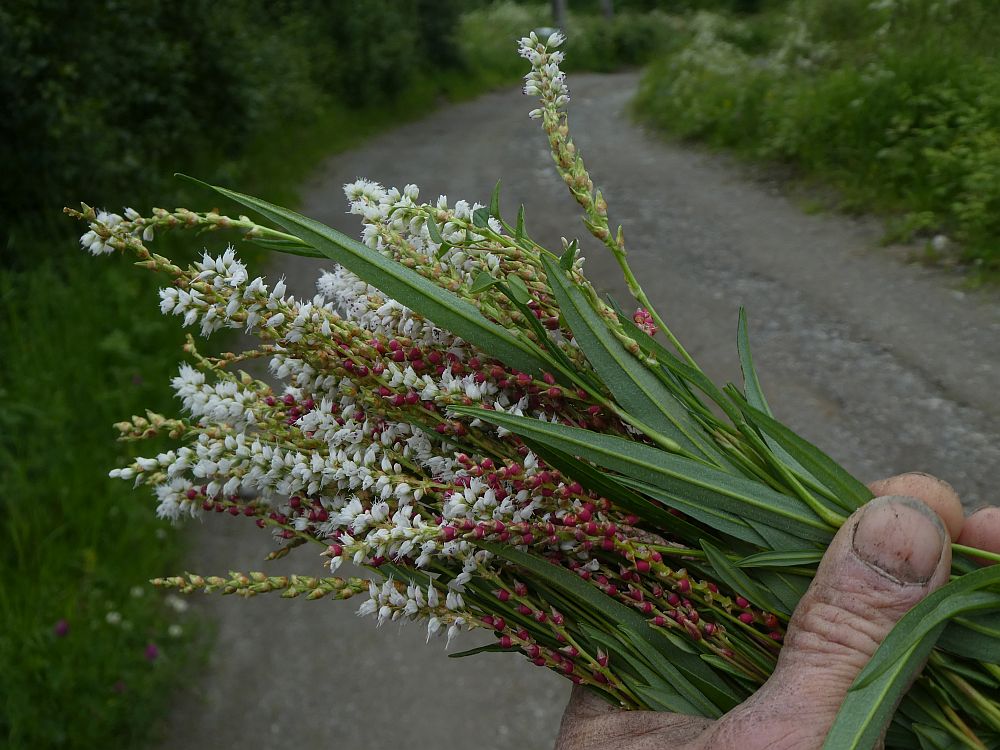
It’s a rare event that I forage outside the garden at this time of year and almost never for leafy greens. I’m trying to find time at least once a week for a walk in the woods and at the weekend I did just that and I was surprised to find that the alpine bistort (viviparous knotweed / harerug) bulbils were ready to harvest. It often grows in large quantities along tracks in sunny spots on the edge of the forest.


We had a perennial veggie quiche for dinner and these were used as as a tasty nutty topping. The vegetables we used included sorrel (Rumex acetosa / engsyre), musk mallow (Malva moschata / moskuskattost), day lily flowers (Hemerocallis / daglilje), various onions (løk), Hablitzia leaves and Hosta.
Sunrise through a Norwegian pine tree this morning, 25th June 2019


On 1st June, I gave a talk at one of Norway’s oldest herb farms, Nordigard Aukrust, run organically by Ola Aukrust since the 1980s. This was my first visit although I’d known of Ola’s work for many years! See the pictures below, including a few Alliums in the beautiful herb garden (immediately below is a summer shot taken from a local tourist page!)

On the bus from the train at Otta to Lom the evening before, I noticed a sign to Valbjør Farm, which my friend and Norwegian Seed Saver (KVANN) Andrew McMillion had visited in 2015. During the visit he had found Allium fistulosum growing on one of the turf roofs and had been given a few onions which he has since shared through KVANN’s Year Book. 10 years ago, I had been on a tour of nearby onion turf roofs near Otta and Vågå (see http://www.edimentals.com/blog/?p=14436). I had heard that there were also onions at Valbjør but hadn’t yet been there. It turned out that the woman who offered to give me a lift from the course at Lom back to Otta, had been at one of my talks some years ago in Heidal. I asked her if we could see Valbjør up on the hills from the main road and told her about the onion roof! Even better, she said, we’ll make a detour to the place.
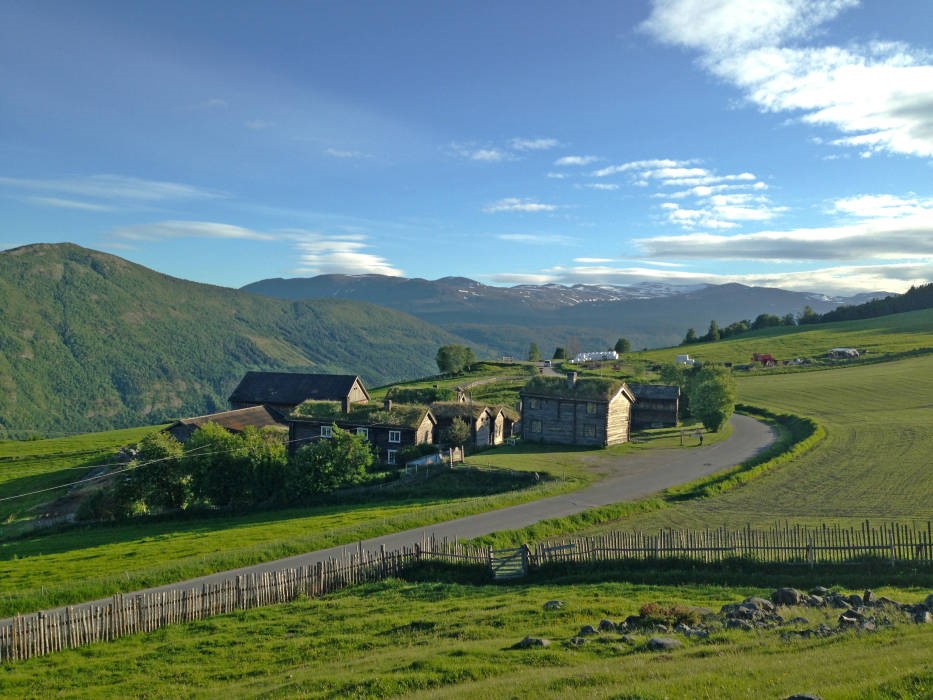
So, it came to pass that we spent 45 minutes or so at the farm and met the long-term organic farmer, Kai Valbjør, who had run the farm organically since the 1980s and, it turned out, was one of the open organic gardens in the national Norwegian organic network which we and Nordigard Aukrust were part of!! It’s all interconnected!! There was also an overgrown herb garden. Valbjør Farm comprises 13 restored buildings from the 17th, 18th and 19th century and is protected by law. A young couple, Ola og Kjerstin Kaurstad, had bought the farm last year and, in particular, Kjerstin was very interested to learn more about the herbs that had survived, despite the neglect. We spent some time looking for herbs and I took a few with me, in case they turn out to be old! There were a few more surprises, see the album at the bottom of this page!
Where did the Valbjør onions come from?
It turned out that the roof onions at Valbjør had not been there for long and had come from another location. Initial information was that they came from Sve Farm (which I had visited and already had onions in the national onion collection at the Ringve Botanical Garden in Trondheim. Kai Valbjør told that Andrew that they had been given them from herbalist Adi Bertoli at Sjoa. Adi was not sure that it was she who had given the onions to Valbjør, but her roof onions came from seed she was given by botanist Hans Shwenke in Otta (who had been on the tour of roof onion locations 10 years previously). Adi remembered that Hans had his onions from a place called Steberløkken in Kvam. Hans confirmed that the farm was probably called Næsset.
Nordigard Aukrust and Lom:

Yesterday was St. John’s Day and many Norwegians (and other Scandinavians) celebrated the evening before what is known here as Sankthans or Jonsok with communal bonfires, the big midsummer celebration on the eve of St. John’s Day! Sankt Hans is a short form of Sankt Johannes (and my grandson is Johannes, so this is for him <3)
There is a special perennial onion which was traditionally harvested on this day in the Netherlands, which I believe to have a much large potential than its current status as a local food crop, as it is so much easier to grow, in particular in areas increasingly suffering from summer droughts and water shortages, along with many other perennial vegetables. If nothing else, it complements shallots and onions in that it is available much earlier in the year!
On a visit to the Utrecht Botanical Gardens in the Netherlands some years ago, I’d photographed an onion called Sint-Jansui and given the botanical name Allium fistulosum var. proliferum.

Botanist Gerard van Buiten at Utrecht later wrote to me “Ah, I see you have found our “St Jansuien! Yes, it is an old local variety, grown around Utrecht. One of our gardeners used to grow it on his nursery a long time ago. Every year on “St. Jansdag”, a box of onions was delivered at Paleis Soestdijk, where Queen Juliana and Prince Bernhard used to live. It is grown nowadays in some urban garden projects in the city”.
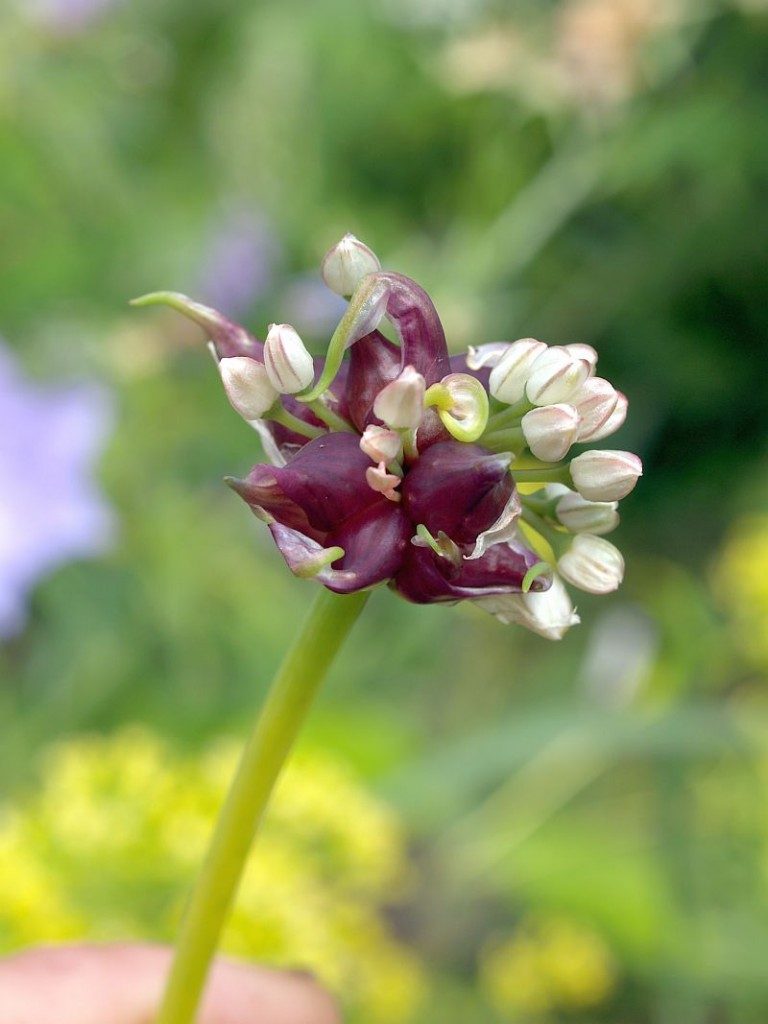
It turns out that this onion is not related to Allium fistulosum and is classified as a triploid hybrid onion Allium x cornutum which has been found both in Europe (Netherlands, France and Croatia) as well as India from where, it is speculated it may have originated. Like Egyptian onion / walking onion (Allium x proliferum), it is sterile and produces bulbils in its inflorescence. I’ve only experienced flowering of this once in 10 years of growing A x cornutum (see below). 10 years ago, Dr. Reinhard Fritsch had sent me 3 accessions from the German gene bank IPK Gatersleben, but only one of these has proven hardy here, although the French accession survived a few years. The other was from India and died the first winter.
In 2014, an open access paper appeared in the BMC Plant Biology journal (see https://bmcplantbiol.biomedcentral.com/articles/10.1186/1471-2229-14-24). This study combined molecular, phylogenetic and cytogenetic data and provided evidence for a unique triparental origin A. × cornutum with three putative parental species, A. cepa, A. pskemense, and A. roylei. Hardiness is probably bestowed by Allium pskemense which has been growing in the Ringve Botanical Gardens in Trondheim for many years.
I had planted the Croatian accession in the new Allium garden at the botanical gardens in Trondheim a couple of years ago and I started harvesting it the other day as it starts to die back at this time of year and looks untidy:
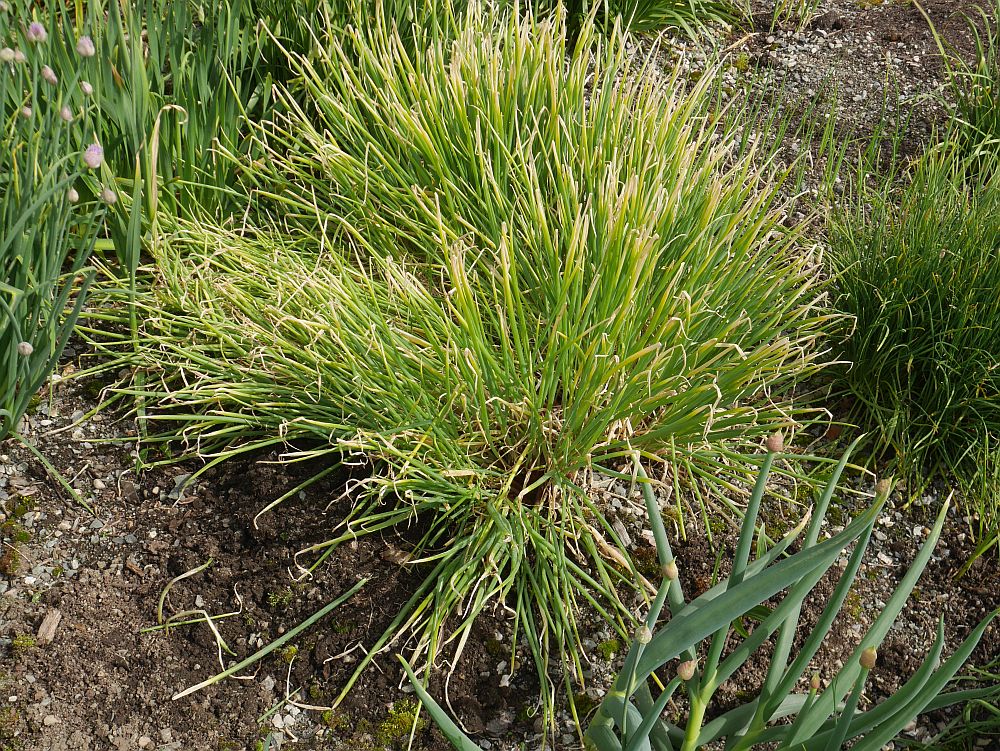
In this little patch, there were an enormous amount of onions, admittedly a bit on the small size, but relatively easy to peel and far outyielding shallots here! I will now harvest these and replant to see how well these yield after one year of growth (I am unsure as to exactly when these were planted, but this may be two years of growth).
I decided to use a small part of this harvest in making bhajis (see http://www.edimentals.com/blog/?p=21561)…and they were delicious!
In Croatia, Puizina, 2013 says: “The term ‘shallot’ in Croatia denotes three genetically and morphologically different, vegetatively reproduced relatives of the common onion, Allium cepa, which are mainly traditionally cultivated for consumption and as a spice: A. cepa Aggregatum group, A. × proliferum and A. × cornutum”. Further, the triploid shallot is “traditionally cultivated in South and coastal Croatia under the name ‘Ljutika’ and it is very popular as a spice and condiment due to its tasty bulbs and leaves”….and “In contrast to most flowering species of Allium in which the leaves are already dying back at flowering time, triploid shallots are perennials, their leaves remain green and suitable for use during entire year”. Ban (2019) shows morphological comparisons of all three types of “shallot” and demonstrates that there are different forms of Allium x cornutum in cultivation, differing in leaf cross-section, bulb shape and leaf waxiness. Bulbs are traditionally preserved in vinegar (Puizina, 2013) as they are difficult to store, resprouting after harvest. It is also stated that A. x cornutum is tolerant of drought and poor soil, enabling it to persist in wild habitats. In fact my own accession of the Croatian shallot originates from such a habitat:
Plant passport data from IPK Gatersleben: “SOURCE – Croatia: Jugoslawien 1985 Dr Hanelt Nr. YUGHAN-85: 5, weedy: Tal zwischen Male Grablje und Milna, offengelassene Olivenpflanzung” (valley between Male Grabje and Milna, open olive plantation). This area has a very different climate than Trondheim, indicating that this is also a very adaptable onion.
The real St. Jansuien shallot from the Netherlands has now also been planted in the onion garden in Trondheim.
I will be making Johannes’ shallots (Sankthans-sjalott) available to members of Norwegian Seed Savers (KVANN) through our autumn catalogue (membership can be had by signing up here: https://kvann.no/bli-medlem . My grandson will also get a packet of onions for his birthday (but, don’t tell him yet…I want it to be a surprise ;) )
References
Ban, S.J., 2019. Samples included in DNA analysis. SafeAlliDiv meeting, Olumuc, April 2019 (Symposium presentation).
Puizina, J., 2013. Shallots in Croatia – genetics, morphology and nomenclature. Acta Bot. Croat. 72 (2), 387–398.
The last two nights, Barley Garlic Weedotto (or Garlic Weed Barlotto) was on the meny at the Edible Garden!
I have a relaxed approach to weeds and weeding and don’t mulch my beds like no dig gardeners do as I consider the weeds to be an important edible resource which increases the yield rather than decreasing as most people think! If weeding becomes harvesting, it becomes less of a chore!
The greens in the barlotto were mostly weeds harvested when weeding my garlic which has grown well despite the ground cover of weeds (the garlic roots are deeper than the weed roots).
NB! Barlotto (Barley risotto) is a local and more nutritious and healthy food as we can’t grow rice !

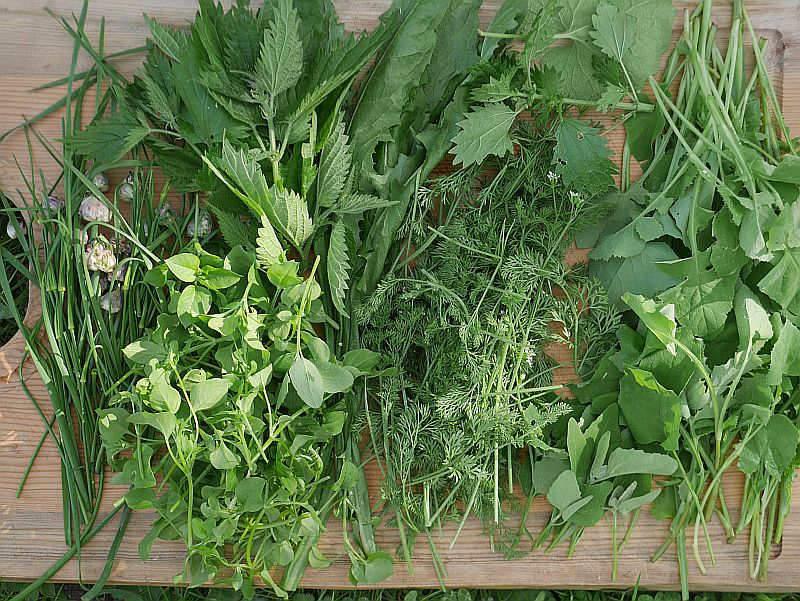





On Sunday 16th June 2019, KVANN (Norwegian Seed Savers) had a stand at the open day at the Ringve Botanical Garden in Trondheim! There were record crowds and good weather and many edimentals passed on to new owners! We sold about 30 different plants! We went plastic free which went very well! Plants were dug up the same morning and the almost bare-root plants were kept moist in glass jars and packed for customers in newspaper, writing the name of each plant on newspaper. We had a full grown flowering Angelica (KVANN) plant on display and both Bordalen and Markusteigen lines of Voss Angelica (see my book) / Vossakvann seedlings were sold. Many people thought the Angelica plant was a Tromsøpalme (similar to Giant Hogweed) and were amazed to see the difference in size between the seedlings and (2 years older), the full grown plant.
Thanks for Meg and Elizabeth for helping out on the stand!
We could have doubled the number of ramsons (ramsløk) plants which sold out quickly!
Thanks also to all the members who came along! Plants were half price for members!